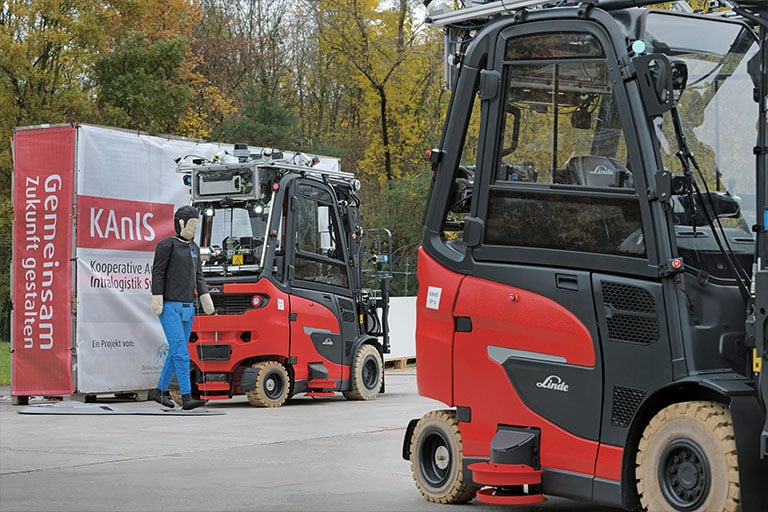Linde Material Handling (MH) and Aschaffenburg University of Applied Sciences (TH AB) presented the results of their research project "KAnIS - Cooperative Autonomous Intralogistics Systems" at an impressive live demonstration on the test site of the Aschaffenburg plant on December 5, 2023.
As part of the project, innovative solutions for autonomous counterbalanced trucks were developed to enable them to handle loads efficiently, even in difficult indoor and outdoor applications. The focus was on cooperative behavior, which enables the vehicles to communicate with each other via a 5G network and an edge server and to warn each other of obstacles in real time. The research, which lasted almost four years, was supported by the "Information and Communication Technology" R&D program of the Free State of Bavaria with around 2.8 million euros.
As one of the leading companies in the industry, Linde MH would like to make the benefits of autonomous vehicles available to customers who use counterbalance trucks to transport goods or load and unload trucks in the future.
The main objective of the project was to investigate how the cooperative behavior of networked, autonomous vehicles can increase operational reliability and handling performance. To this end, various sub-projects were initiated that dealt with topics such as localization, control, cooperation, load carrier recognition, dealing with weather conditions, predictive maintenance, route optimization and automatic load management.
Endurance tests under real conditions
Four automated Linde E20, E25 and E30 electric counterbalance trucks with load capacities of 2.0 to 3.0 tons were used in practical test scenarios under real-life conditions. These were equipped with electro-hydraulic steering (Linde Steer Control), the Linde Safety Pilot assistance system and an integrated fork positioner. From next year, the vehicles will be further developed and tested to take on specific material flow tasks in the plant. These include the transportation of lattice boxes and pallets with batteries as well as vehicle frames and overhead guards, which are transported on special load carriers from the pre-assembly lines to the main assembly lines.
The first two areas of use are exclusively outdoor applications, while in the other two, the forklifts move both inside and between halls. The vehicles have to cope with gradients of up to 8 percent and share the space with other AGVs and manually controlled vehicles. In order to be able to pick up pallets, pallet cages and metal racks in positions that are not perfectly aligned, the four KAnIS trucks are equipped with a moving camera mounted between the forks. This camera measures the position of the load carrier pockets in order to position the forks precisely over the sideshift. In addition, the vehicle frame, the battery door and the counterweight of the test trucks were also modified accordingly.
The vehicles use laser scanners for localization inside the halls. Outside, a differential GPS (Global Positioning System) is used, a method for increasing GPS precision. Local sensors are also used when moving from indoor to outdoor areas. In contrast to manually operated forklifts, the automated models always move backwards on defined routes to prevent the load from falling off the forks in the event of an emergency stop.
Forklift and environment in constant exchange
The research project placed a particular focus on the perception of the automated forklifts' surroundings in order to ensure safe interaction with other road users. In addition to the sensors of the personal protection system, the vehicles are therefore also equipped with 3D scanners and HD cameras. This camera data is essential for the detection, classification and localization of objects using artificial intelligence (AI), which enables the trucks to adjust their speed and slow down to a standstill if necessary. A central aspect of the project was also the management of critical situations that can occur when other road users are in the blind spot of the forklift sensors and approach the route. In such cases, cooperation between the forklift trucks is crucial. A nearby forklift truck can provide valuable information here, provided the data transmission takes place in real time. To achieve these low latencies, a private 5G network was implemented at the Aschaffenburg plant. The perception data from the forklifts is sent to an edge server, which creates a comprehensive list of all detected objects and sends this information back to the forklifts.
In test scenarios, a crash test dummy was used that unexpectedly emerges from behind a wall and runs onto the route. Without cooperative systems, the automated truck cannot stop in time and collides with the dummy. However, if it receives real-time information from another truck nearby, the vehicle can recognize the danger in advance and slow down accordingly. However, as there will not always be a second truck nearby, eight stationary 3D laser scanners were installed at important junctions and passages along the planned routes of the KAnIS trucks. The local object lists recorded by these scanners are also merged on the edge server and made available to all vehicles.
Cleaning of sensors and battery charging by robot
Another work package focused on how the optical sensors mounted close to the ground can be cleaned, especially if they are soiled by splashing water in the rain or wet road surfaces. Unreliable object detection due to dirty sensors would cause the safety devices to stop the truck automatically. To avoid this, the team developed a cleaning system that uses compressed air to remove the droplets of dirty water that accumulate on the laser scanners.
In addition, another team worked on the development of solutions for autonomous charging of the truck batteries. The solution chosen was an AI-based robot that automates the charging process by connecting the charging plug to the truck's charging socket. To make this possible, the rear of the truck was modified and equipped with an automatically operated charging flap that protects the charging socket from contamination and splash water.

